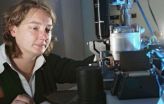(Press-News.org) INDIANAPOLIS – A study published earlier this year in the peer reviewed online journal BMC Public Health has found that residing in a neighborhood with adverse living conditions such as low air quality, loud traffic or industrial noise, or poorly maintained streets, sidewalks and yards, makes mobility problems much more likely in late middle-aged African Americans with diabetes.
"We followed a large group of African Americans for 3 years and found an extremely strong correlation between diabetes and adverse neighborhood conditions. The study participants were between the ages of 49 and 65 years with no or limited mobility problems at the beginning of the study," said study senior author Douglas K. Miller, M.D., Richard M. Fairbanks Professor in Aging Research at the Indiana University School of Medicine and a Regenstrief Institute research scientist.
The researchers knew that, as diabetics, these individuals were prone to develop lower-body functional limitations at a relatively young age. What they discovered was a double jeopardy situation.
"Having diabetes is bad, living under adverse neighborhood conditions is bad, but people with diabetes who live in adverse neighborhood conditions quite remarkably were up to 80 times more likely to develop lower body functional limitations than those having the disease or living under these neighborhood conditions alone," said Dr. Miller. "In fact, in our study about 8 out of 10 people who developed lower body functional limitations were diabetics who lived in adverse neighborhood conditions."
Limitations encountered by the individuals with diabetes noted in the study include difficulty with daily functions such as walking a quarter mile (approximately three city blocks) or climbing up and down stairs. The strong link between adverse neighborhood conditions and reduced mobility existed even when the researchers adjusted for exercise, so lack of exercise did not account for the diminished abilities.
"It can be stressful living in these neighborhoods and psychological stress produces oxidative stress physiologically, which diabetics don't tolerate well," said Dr. Miller, who is an internist and associate director of the Indiana University Center for Aging Research. "This may be one of the reasons why living in adverse neighborhood conditions exacerbates the detrimental effects on lower body functioning associated with diabetes."
Surprisingly, while the researchers found a strong link between residing in a neighborhood with adverse conditions and diabetes, they did not find a similar link for hypertension or arthritis, so the negative interaction with adverse neighborhood conditions appears to be specific to diabetes.
The research team from Indiana University School of Medicine, the Regenstrief Institute, Washington University in St. Louis and the universities of Florida and Iowa studied 563 men and women age 49 to 65 in St. Louis.
"African Americans have more disability than whites, and it's even worse in inner-city areas with low socioeconomic status. People may live in urban neighborhoods with great people, wonderful churches and long civic histories, but excessive neighborhood noise and crumbling infrastructure are bad for health, especially for individuals with diabetes. We need to further study how the environment 'gets under the skin' so we can halt the interaction between diabetes and adverse living conditions that leads to decreased mobility," said Dr. Miller.
INFORMATION:
In addition to Dr. Miller, authors of "Neighborhood conditions, diabetes, and risk of lower-body functional limitations among middle-aged African Americans: A cohort study" are Mario Schootman, Ph.D.; J. Philip Miller, M.S., and Yan Yan, M.D., Ph.D., of Washington University of St. Louis; Elena M. Andresen, Ph.D., of the University of Florida, and Fredric D. Wolinsky, Ph.D., of the University of Iowa.
The study was funded by the National Institute on Aging.
The IU School of Medicine and the Regenstrief Institute are located on the Indiana University-Purdue University Indianapolis campus.
Adverse neighborhood conditions greatly aggravate mobility problems from diabetes
2010-10-22
ELSE PRESS RELEASES FROM THIS DATE:
AFM tips from the microwave
2010-10-22
Jena (21 October 2010) Scientists from the Friedrich-Schiller-University Jena (Germany) were successful in improving a fabrication process for Atomic Force Microscopy (AFM) probe tips.
Atomic Force Microscopy is able to scan surfaces so that even tiniest nano structures become visible. Knowledge about these structures is for instance important for the development of new materials and carrier systems for active substances. The size of the probe is highly important for the image quality as it limits the dimensions that can be visualized – the smaller the probe, the smaller ...
Pitt researchers: Plant-based plastics not necessarily greener than oil-based relatives
2010-10-22
PITTSBURGH—An analysis of plant and petroleum-derived plastics by University of Pittsburgh researchers suggests that biopolymers are not necessarily better for the environment than their petroleum-based relatives, according to a report in Environmental Science & Technology. The Pitt team found that while biopolymers are the more eco-friendly material, traditional plastics can be less environmentally taxing to produce.
Biopolymers trumped the other plastics for biodegradability, low toxicity, and use of renewable resources. Nonetheless, the farming and chemical processing ...
Smaller is better in the viscous zone
2010-10-22
DURHAM, N.C. -- Being the right size and existing in the limbo between a solid and a liquid state appear to be the secrets to improving the efficiency of chemical catalysts that can create better nanoparticles or more efficient energy sources.
When matter is in this transitional state, a catalyst can achieve its utmost potential with the right combination of catalyst particle size and temperature, according to a pair of Duke University researchers. A catalyst is an agent or chemical that facilitates a chemical reaction. It is estimated that more than 90 percent of chemical ...
Carnegie Mellon researchers break speed barrier in solving important class of linear systems
2010-10-22
PITTSBURGH—Computer scientists at Carnegie Mellon University have devised an innovative and elegantly concise algorithm that can efficiently solve systems of linear equations that are critical to such important computer applications as image processing, logistics and scheduling problems, and recommendation systems.
The theoretical breakthrough by Professor Gary Miller, Systems Scientist Ioannis Koutis and Ph.D. student Richard Peng, all of Carnegie Mellon's Computer Science Department, has enormous practical potential. Linear systems are widely used to model real-world ...
Light on silicon better than copper?
2010-10-22
DURHAM, N.C. -- Step aside copper and make way for a better carrier of information -- light.
As good as the metal has been in zipping information from one circuit to another on silicon inside computers and other electronic devices, optical signals can carry much more, according to Duke University electrical engineers. So the engineers have designed and demonstrated microscopically small lasers integrated with thin film-light guides on silicon that could replace the copper in a host of electronic products.
The structures on silicon not only contain tiny light-emitting ...
Too many sisters affect male sexuality
2010-10-22
Growing up with lots of sisters makes a man less sexy. For rats, anyway. A new study published in Psychological Science, a journal of the Association for Psychological Science, finds that the sex ratio of a male rat's family when he's growing up influences both his own sexual behavior and how female rats respond to him.
David Crews, a psychobiologist at the University of Texas at Austin, is interested in how early life affects behavior later. This is an area that has received a lot of attention recently, such as research showing that the position of a fetus in the uterus ...
Strategies for translational research in the UK
2010-10-22
A commentary published in the journal, Science Translational Medicine, examines the structures of translational research investment in the UK.
The commentary has been written by researchers from the National Institute for Health Research (NIHR) comprehensive Biomedical Research Centre (BRC) at Guy's and St Thomas' and King's College London. The authors consider the results of substantial Government and charitable investment in translational research taking place within the NHS.
The commentary follows the progress of the research and development funding streams available ...
Poor start in life need not spell doom in adulthood
2010-10-22
RIVERSIDE, Calif. – Does the environment encountered early in life have permanent and predictable long-term effects in adulthood? Such effects have been reported in numerous organisms, including humans.
But now a biology graduate student at the University of California, Riverside reports that how individuals fare as adults is not simply a passive consequence of the limits that early conditions may impose on them. Studying how adult Trinidadian guppies (small freshwater fish) responded to their early food conditions, Sonya Auer found that the guppies had compensated ...
Researchers find better method to help mothers cope with child's cancer and related stress
2010-10-22
VIDEO:
Martha Askins explains problem-solving skills training.
Click here for more information.
BOSTON - Mothers who have children diagnosed with cancer now have a better approach to address and cope with stresses associated with their child's disease.
A new certified intervention has proven to be more effective long term compared to other psychological methods, as reported today at the 42nd Congress of the International Society of Pediatric Oncology.
In a joint ...
Study finds airbags reduce risk of kidney injury in car crashes
2010-10-22
CHICAGO (October 21, 2010) – Occupants in motor vehicles with airbags are much less likely to suffer kidney or renal damage in a crash than are occupants in vehicles without airbags, according to a new study in the September Journal of the American College of Surgeons.
Little is known about how to prevent or reduce injury to solid organs from motor vehicle collisions. In fact, this study is the first to evaluate the protective effect of airbags on a specific organ system – in this case, the kidney and other renal, or upper urinary tract, organs.
The researchers found ...





